| Columns Retired Columns & Blogs |
Kinergetics KCD-40 CD player 1990 Measurements
Sidebar 2: 1990 Measurements
Footnote 1: When a signal is accompanied by truly random noise, averaging more than one sample reduces the amount of noise by 3dB for each doubling of the number of samples. This is because the wanted signal will add with each doubling—ie, increases by 6dB—whereas the noise will only add by 3dB because its random nature means that it has just as much chance of canceling when summed as it does of adding.—John Atkinson
On the test bench, the Kinergetics KCD-40 exhibited a flat frequency response with a slight (–0.5dB) rolloff at 20kHz (fig.1). The 0.4dB level difference between channels is due to the two channels not being set to quite the same level when the coupled volume controls are visually equivalent. (This can be corrected, of course, by adjusting one friction-locked control only.) As suspected during the auditioning, however, the player's deemphasis circuitry did introduce a small degree of response error, –0.22dB at 4kHz, +0.25dB at 10kHz, and +0.4dB at 16kHz. This would be audible as a degree of added HF "air," perhaps coupled with a slight exaggeration of depth, when preemphasized discs are played. Interchannel phase was perfect across the band, and the output polarity was correct; ie, non-inverting.

Fig.1 Kinergetics KCD-40, frequency response (right channel bottom, 0.5dB/vertical div.).
The maximum output with the volume control all the way up was a high 7.12V. The KCD-40 will have no problems in driving even the most insensitive power amplifier to full output when directly connected to it. The use of a volume pot after the output stage often means that the user will have to take care about matching with interconnects and power amplifiers if the highs are not to be rolled off and the lows to lack dynamics. Looking at the KCD-40's output impedance at three typical positions—full up, volume control at 12 o'clock, and at 9 o'clock—gave results of 2 ohms, 780 ohms, and 150 ohms, respectively. The maximum output impedance was with the control around 2 o'clock, when it reached 2000 ohms or so. I can't see that there will be any interfacing problems with the KCD-40, even with relatively long interconnects.
Spectral analysis of the output when playing a dithered 1kHz, –90dB tone is shown in fig.2. (The dotted trace is the right channel.) The KCD-40 had a very low level of residual noise and only inconsequential power-supply–related intrusion into the audio signal (though the right channel can be seen to be a little worse in this respect). The right channel also featured a slight degree of second-harmonic distortion compared with the left, though if either channel has any higher harmonics, they are buried in HF noise.
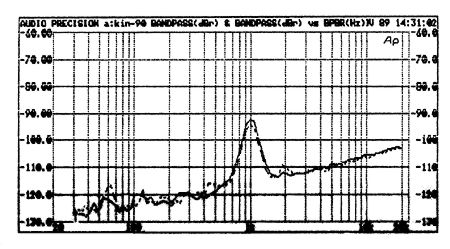
Fig.2 Kinergetics KCD-40, spectrum of dithered 1kHz tone at –90.31dBFS, with noise and spuriae (1/3-octave analysis, right channel dashed).
Fig.2 suggests that linearity was not identical between channels, which was confirmed by plotting the departure from the correct level (figs.3 and 4, left and right channels, respectively). The left channel featured 2dB or less negative error at –90dB and –100dB, which is excellent. The right channel, however, was marginal with a maximum error of approximately –5dB at –100dB, this correlating with the increased second-harmonic level apparent in the –90dB spectrum. Listening to the left channel, the 500Hz tone on the "Fade to Noise With Dither" track on the CBS Test Disc sounded commendably pure on the left channel as it faded to silence, but it was overlaid with hashy-sounding HF noise.

Fig.3 Kinergetics KCD-40, departure from linearity, left channel (2dB/vertical div.).

Fig.4 Kinergetics KCD-40, departure from linearity, right channel (2dB/vertical div.).
The KCD-40's good low-level linearity can also be seen in the way it reproduced the CBS disc's monotonicity staircase waveform (fig.5), which has even "steps." However, I must admit to cheating a little to get this graph by using an audio-band low-pass filter to eliminate ultrasonic noise. This player did feature a degree of HF rubbish in its output—the waveform of an a –90dB undithered 1kHz tone was overlaid with HF noise. Again, switching a low-pass filter in-circuit to remove the spectral content above 20kHz (fig.6) shows that the characteristic three-level waveshape is reasonably well reproduced by the KCD-40.
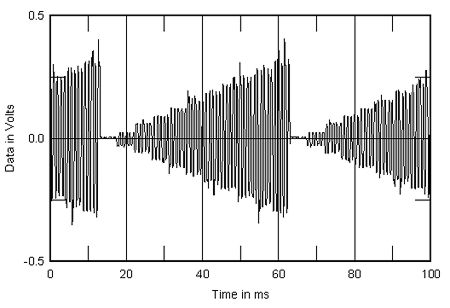
Fig.5 Kinergetics KCD-40, monotonicity waveform from CBS Test CD 1 low-pass–filtered (–1dB at 20kHz) to remove HF noise.
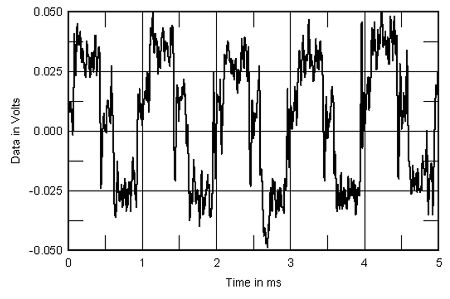
Fig.6 Kinergetics KCD-40, waveform of undithered 1kHz sinewave at –90.31dBFS, low-pass–filtered (–1dB at 20kHz) to remove HF noise (5ms time window).
The dithered low-level tracks on the CBS disc should reproduce on a perfect 16-bit player as a pure, if noisy, sinewave. Fig.7 shows that, indeed, the KCD-40's left channel does produce a reasonably good sinewave, though it must be noted that this trace was again taken with the low-pass filter in-circuit, and 32 individual samples were averaged to lower the level of residual audio-band noise (footnote 1).
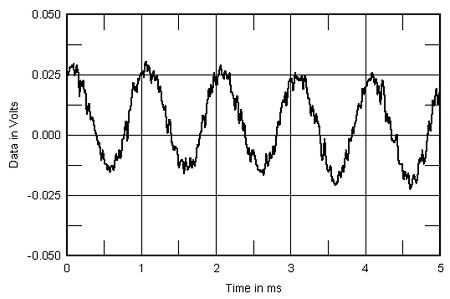
Fig.7 Kinergetics KCD-40, waveform of dithered 1kHz sinewave at –90.31dBFS low-pass–filtered (–1dB at 20kHz) to remove HF noise. 32 samples averaged to lower the level of audio-band noise (5ms time window).
Finally, what of the KCD-40's high-level performance? Fig.8 shows the manner in which it reproduces a 0dB, 1kHz squarewave. The symmetrical ringing reveals the linear-phase nature of the Sony 8x-oversampling FIR digital filter chip. Note, however, the clipped nature of the waveform peaks when compared with the same wave decoded by a top-quality Philips filter/DAC combination (in the Philips LHH1000 player) in fig.9. The correct shape is the Philips, with a degree of overshoot present, the ringing decaying with time; the Sony filter actually overloads when fed the data representing this signal, something I also noted when measuring the Tempest Special Edition player, which uses the same filter chip. I would hazard a guess that this filter is optimized for low-level performance. And to be honest, why not? A 0dB squarewave is the one signal that you will never come across when playing recorded music.
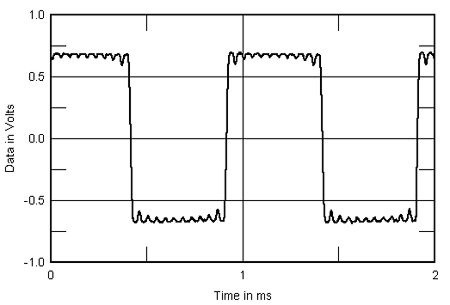
Fig.8 Kinergetics KCD-40, waveform of 1kHz squarewave at 0dBFS.
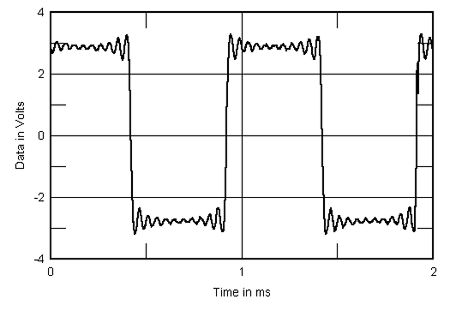
Fig.9 Philips LHH1000, waveform of 1kHz squarewave at 0dBFS.
The KCD-40's error-correction capability turned out to be pretty good, all the tracks on the Pierre Verany test disc being handled up to 38, a single 4mm gap in the data every revolution, when the sound clicked severely. The tracks featuring dropouts in addition to the minimum track pitch allowed by the CD standard were passed OK up to 43 (the one with a 2.4mm dropout), which muted at the start of the track, while the tracks featuring two dropouts in quick succession were again negotiated successfully up to 50 (which has two 3mm dropouts).—John Atkinson
Footnote 1: When a signal is accompanied by truly random noise, averaging more than one sample reduces the amount of noise by 3dB for each doubling of the number of samples. This is because the wanted signal will add with each doubling—ie, increases by 6dB—whereas the noise will only add by 3dB because its random nature means that it has just as much chance of canceling when summed as it does of adding.—John Atkinson
- Log in or register to post comments



































